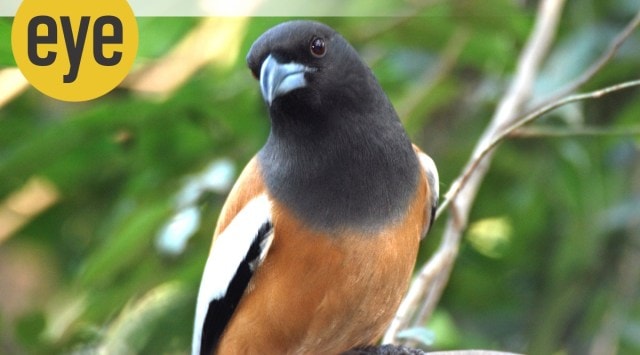What I saw from my hospital window
In India, pet therapy may yet not be a legit line of treatment, but staring at birds outside a hospital-room window can be therapeutic
 Healing Touch: Rufous treepie (Credit: Ranjit Lal)
Healing Touch: Rufous treepie (Credit: Ranjit Lal)Many hospitals around the world now include “pet therapy” as a part of the treatment and recovery process. Well-socialised dogs (and, maybe, cats), bunnies, guinea pigs and, perhaps, even a rude parakeet or two “visit” their patient clients regularly and raise their spirits, helping them recover more quickly.
I don’t know if this line of treatment is being followed by hospitals in India but I do know that all I had to do was to stare outside the enormous plate-glass window of the hospital room I was in and the birds outside did the rest for me. It was a widescreen window, open to the sky (mercifully, blue) and at the canopy level of trees (I suspect desi papdi aka chamrod) growing across the road, bushes and hedges below, and bordering a little sunflower garden in the heart of south Delhi. Time at your disposal, you sit at the window and watch the goings-on. Within two days, you’d begin to notice patterns emerge: like us (and the schoolchildren trudging to the school across the road) the birds, too, had a routine. They were all normal aam-junta birds who, like normal aam-junta city-dwellers, went about their daily affairs — but with one big difference. None of them scowled or seemed surly; they seemed to be in the blithest of spirits, which rubbed off on you no matter how much of a hypochondriac you tried to make yourself to be!
Every evening squadrons of rosy starlings would streak across the sky in tight bunches intent on destroying some distant target (a fruiting peepul, perhaps). Their cousins the common mynas would fly in smaller more disorganised rabbles, their squat silhouettes and propeller-like wings invariably reminding you of the wonderful Spitfire fighters of World War II. The big black kites skated past at window level, banking and swooping and occasionally engaging with each other. One pair had a large scraggly nest in one of the trees and every morning, the mother would leave the nest and perch on a bare branch nearby, keeping watch. Her fledglings must have been loutish teens by now, because she didn’t visit (or feed) them all that often — encouraging them to get off their butts, perhaps, and fend for themselves!
The cluster of papdi trees attracted a clientele of green pigeons, who simply dived in and vanished in the canopy and the always grinning, somewhat foolish-looking brown-headed barbet. You could hear these guys calling even through the window glass — but they, too, simply vanished once they were permitted entry into what I had begun calling the “Papdi-Hotel”. Down below at the edge of the little sunflower garden, a pair of Red-vented bulbuls were obviously bringing up a family in the middle of a bougainvillea creeper nearby. Every now and then, one of the parents would alight nearby, look around hastily and dive into the creeper, only to emerge a little while later and whirr off. She (and probably her partner) was least bothered by the tremendous clanging racket emerging from her neighbours, who were constructing some monstrosity out of large flashy aluminium sheets (probably, something for the air-conditioning plant) by cutting and hammering them to shape.
 Healing Touch: Rosy starlings racing past (Credit: Ranjit Lal)
Healing Touch: Rosy starlings racing past (Credit: Ranjit Lal)
The parakeets as always were the most wild and wanton: they streaked across the skies at random like bullet-headed missiles, screaming their heads off as they swerved and banked, showing off the hundreds of shades of emerald in their plumage as they did so. Watch a flock of parakeets for five minutes and you cannot help but smile. But yes, there was also the furtive and sinister. On my last morning, I noticed a pair of rufous treepies systematically clambering up the branches of a fish-tail palm tree growing alongside the building, searching with all the thoroughness of the Enforcement Directorate dispatched on orders of the highest dispensation. Now, treepies are known for their appetite for baby birds and eggs, so this was not promising. Too much of the tree was hidden from me, and I couldn’t figure out whether they had found a nest in the end — but the thoroughness of their search gave you the chills.
One advantage of this kind of confined birding is that it forces you to observe. Most birders are content on ticking off species on their list and marching on: here you are stuck with one viewpoint all day. And this is when the patterns in the lives of birds begin to manifest themselves and you begin to think, hey, you know they’re not living random vagabond lives (like so many of us do). Extrapolate that to every other living creature on earth and you will realise that it’s all one enormous living system working perfectly in harmony — not so much for the survival of the system itself as for that of each genetic component of it.
Then, shortly before being discharged, I watch a fluffy white, down feather float up to the window, rocking on the air currents, like a boat on a lake. It leans against the window for a long moment before drifting away into the wild blue yonder.
Back home, I am awoken at 3 am by the peacocks next door — mewling and screaming — back from some karaoke orgy. As dawn filters in, the koels yodel their egg-dumping schemes to one another, and then, the bunch of babblers living across the wall break into their clamorous cacophony. And punctually at sunrise, your personal red-whiskered bulbul alarm on the window bougainvillea begins its mellifluous wake-up call.
- 01
- 02
- 03
- 04
- 05































